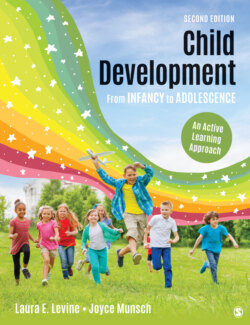Читать книгу Child Development From Infancy to Adolescence - Laura E. Levine - Страница 154
На сайте Литреса книга снята с продажи.
Correlational Designs
ОглавлениеIn a correlational research design, a researcher examines the relationship between two or more naturally occurring variables, such as self-esteem and children’s academic achievement. When we look at correlations, we are interested in two characteristics: the strength of the relationship and the direction of the relationship. Figure 2.8 will help you visualize these aspects of correlations as we describe them. We talk first about the direction of the relationship. Correlations can be positive or negative. In a positive correlation, the value of one variable increases as the value of the second variable increases. For example, lifetime earnings are positively correlated with the number of years in school. As years completed in school go up, so do lifetime earnings. In a negative correlation, as the value of one variable increases, the value of the second variable decreases. For example, the more often people brush their teeth, the lower their rate of tooth decay.
Correlational research design: Research that measures the strength and direction of the relationship between two or more variables that are not created by the experimenter.
The second characteristic of correlations is the strength of the relationship between the two variables. This can range from a correlation of +1.0 (a perfect positive correlation) to a correlation of –1.0 (a perfect negative correlation). At either of these extremes, a change of one unit of measurement in one of the variables is accompanied by a change of one unit of measurement in the second variable, so if we knew someone’s score on one variable, we could perfectly predict her score on the second variable. As a correlation moves from +1 or –1 toward 0, the relationship between the variables gets weaker and weaker. Look at Figure 2.8 for an illustration of a weak correlation versus a strong correlation. An increase in the value of one of the variables is now associated with a range of values for the second variable. For instance, the correlation between people’s shoe size and their IQ is probably close to zero so if you know someone’s shoe size there would be such a large range of possible IQs associated with it that you would not be able to predict what that person’s IQ would be. Many correlations in developmental research are in the moderate range of ±.15 to ±.40.
Description
Figure 2.8 Examples of correlations.
Source: Adapted from Columbia University, 2015.
Let’s think about how you can use information from correlational data. If you read an article in your local newspaper that said, “Study finds that mothers who talk to their children a great deal have children with high self-esteem,” could we correctly conclude that frequent conversations with children will build their self-esteem? We could not. Because the researchers could not control how much mothers in this study talked to their children, this is clearly correlational research. Correlational research tells us that there is a relationship between two variables (in this case, mothers’ conversations and children’s self-esteem), but a third variable that wasn’t even measured might be responsible for the relationship we observed. For instance, it may be that the mothers who talked a lot to their children were also ones who gave their children a lot of praise and positive feedback. In this case, it would be the nature of what they said rather than the amount of conversation that affected the children’s self-esteem. For this reason, we must use caution when interpreting correlational findings because the fact that two things occur together does not mean that one of them necessarily caused the other.
In Chapter 1, you were advised to be a careful consumer of information about development. If you know that when there is a correlation between two variables it is not the same thing as saying that one causes the other, it will make you a better consumer of information you might hear on television or read on the Internet.
TRUE/FALSE VIDEO
T/F #10
Even if research consistently finds that children whose mothers talk to them a great deal have high self-esteem, we should not conclude that frequent conversations with parents build self-esteem in children. True
